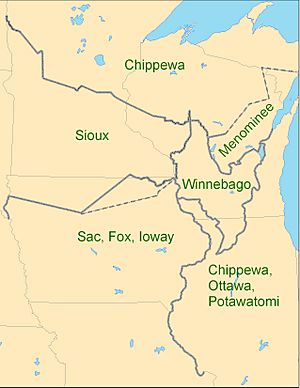First Treaty of Prairie du Chien facts for kids
The Treaty of Prairie du Chien refers to several important agreements. These treaties were signed in Prairie du Chien, Wisconsin. They were made between the United States government and several Native American nations. These nations included the Sioux, Sac and Fox, Menominee, Ioway, Winnebago, and the Anishinaabeg. The Anishinaabeg group included the Chippewa, Ottawa, and Potawatomi peoples.
What Was the Treaty of Prairie du Chien?
The First Treaty of Prairie du Chien was a major agreement. It was signed on August 19, 1825. The United States was represented by William Clark and Lewis Cass. Many Native American nations also had representatives there. These included the Sioux, Sac and Fox, Menominee, Ioway, Winnebago, and the Anishinaabeg. The Anishinaabeg included the Chippewa and the Council of Three Fires (Chippewa, Ottawa, and Potawatomi). This treaty officially became law on February 6, 1826.
Why Was This Treaty Needed?
At this time, many Native American tribes were moving west. This was because more and more settlers were moving onto their lands. The Sioux Nation lived in these western areas. They often clashed with other tribes moving into their traditional territories. The United States wanted to stop these conflicts. So, they negotiated this treaty to try and reduce fighting between the tribes.
How Did the Treaty Work?
The treaty started by creating peace among the Sioux and their neighbors. These neighbors included the Chippewa, Sac and Fox, and Ioway peoples. After that, the treaty drew official borders between each tribal group. These borders were often called the "Prairie du Chien Line."
The treaty also stated that the United States had control over these lands. For Native American peoples, who were used to hunting and traveling freely over large areas, these new lines were difficult. The treaty said that tribes could only hunt within their new, agreed-upon borders.
Because this treaty covered such a large area, not all tribes could send representatives. So, the treaty planned for more meetings. These additional councils happened in 1826, like the Treaty of Fond du Lac. The Chippewa also agreed to attend more meetings.
The United States later used these Prairie du Chien Lines. They became the boundaries for land that Native American nations gave up in future treaties.



